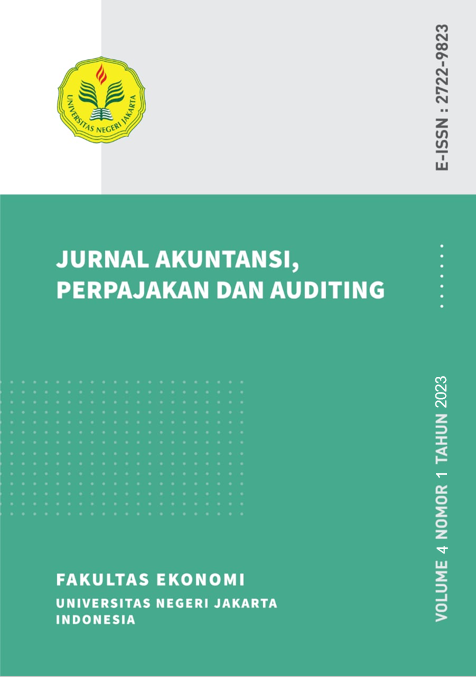Analisis Faktor-Faktor yang Mempengaruhi Minat Wajib Pajak dalam Menggunakan Sistem E-Filling
DOI:
https://doi.org/10.21009/japa.0401.13Keywords:
Performance Expectations, Business Expectations, Social Influence, Facilitating Conditions, Interest in Using the E-filling systemAbstract
E-filling is a form of modernization of taxation as a means of reporting digital or online tax returns (SPT) via the internet on the DGT online website. The application of E-filling aims to make it easier for taxpayers to report their taxpayers, so that it is expected to increase taxpayer compliance which has an impact on increasing state treasury revenues. However, the tax increase has not been followed by an increase in the number of E-filling users where there are still taxpayers who report their SPT manually. This is evidenced by the figure of 58% of registered taxpayers using the E-filling system in 2018. One of the factors causing the lack of optimal implementation of the E-filling system is caused by a lack of interest in individual behavior in using the E-filling system. The purpose of this study was to examine the effect of performance expectations, business expectations, social influence, and facilitating conditions on interest in using the E-filling system. This research is a quantitative study and data collected using a survey system (questionnaire).
References
Asosiasi Penyelenggara Jasa Internet Indonesia. (2020). Laporan Survei Internet APJII 2019–2020. Asosiasi Penyelenggara Jasa Internet Indonesia, 2020, 1–146. https://apjii.or.id/survei
Damayanti, S. L., Yani, Y., Asnaini, A., & Afrianty, N. (2021). Minat Menggunakan E-Wallet pada Generasi Milenial dengan Pendekatan UTAUT (Unified Theory of Acceptance Use of Technology). Jurnal BAABU AL-ILMI: Ekonomi dan Perbankan Syariah, 6(1), 63. https://doi.org/10.29300/ba.v6i1.3988
DDTC. (2018). Rendahnya Tax Ratio, Pesan IMF Untuk Indonesia. Ddtc.Com. https://news.ddtc.co.id/singgung-rendahnya-tax-ratio-ini-pesan-imf-untuk-indonesia-13845
DeLone dan McLean. (2003). The DeLone and McLean Model of Information Systems Success: A Ten-Year Update. Journal of Management Information Systems, 19(4), 9–30. http://mesharpe.metapress.com/content/PEQDJK46VY52V4Q6
Fuksa et al. (2013). Mobile Technologies and Services Development Impact On Mobile Internet Usage In Latvia. Procedia Computer Science, 26 (December 2013), 41–50. https://doi.org/10.1016/j.procs.2013.12.006
Hardika, N. S., & Ermawati, N. K. (2018). Pengaruh Ekpektasi Kinerja, Ekpektasi Usaha, dan Faktor Sosial Terhadap Perilaku Wajib Pajak Menggunakan E-Filing. Account, 5(2), 858–868.
Hartono, J. (2007). Sistem Informasi Keperilakuan. Andi.
I.G N. Sedana, & S.W. Wijaya. (2010). UTAUT Model for Understanding Learning Management System. Internetworking Indonesia Journal, 2(2), 27–32.
Im et al. (2010). An International Comparison of Technology Adoption: Testing the UTAUT model. Information and Management, 48(1), 1–8. https://doi.org/10.1016/j.im.2010.09.001
Imam Ghozali. (2016). Aplikasi Analisis Mulrtivariete Dengan Program, IBM SPSS 23. Badan Penerbit Universitas Diponegoro.
Indah, M., & Agustin, H. (2019). Penerapan Model Utaut (Unified Theory Of Acceptance and Use Of Technology) Untuk Memahami Niat dan Perilaku Aktual Pengguna Go-Pay Di Kota Padang. Jurnal Eksplorasi Akuntansi, 1(4), 1949–1967. https://doi.org/10.24036/jea.v1i4.188
Juliansyah. (2014). Analisis Data Penelitian Ekonomi dan Manajemen.Gramedia.
kemenkeu.go.id, 2014. (2014). e-Filing: Praktis, Mudah, Ramah Lingkungan. Https://Www.Kemenkeu.Go.Id/Publikasi/Berita/e-Filing-Praktis-Mudah-Ramah-Lingkungan/. 27/10/2021
Kinerja Laporan DJP. (2019). Laporan Kinerja Direktorat Jenderal Pajak Tahun 2019. Kementerian Keuangan Republik Indonesia Direktorat Jendral Pajak, 021, 1–169. https://www.pajak.go.id/sites/default/files/2019-05/LAKIN DJP 2018.pdf
online-pajak.com. (2017). Modernisasi Administrasi Perpajakan: Upaya Penyempurnaan Pelayanan Pajak (I). Www.Online-Pajak.Com. https://www.online-pajak.com/tentang-efiling/modernisasi-administrasi-perpajakan-upaya-penyempurnaan-pelayanan-pajak-bagian-1-1
online-pajak.com. (2018). e-Filing pajak.go.id: Sejarah Aplikasi Pajak Milik Pemerintah. Www.Online-Pajak.Com. https://www.online-pajak.com/tentang-efiling/e-filing-pajakgoid
online-pajak.com. (2019). 8 Alasan Keamanan Data Anda Terjamin di OnlinePajak. Www.Online-Pajak.Com. https://www.online-pajak.com/tips-efiling/8-alasan-keamanan-data-anda-terjamin-di-onlinepajak
Sanusi. (2014). Metode Penelitian Bisnis. Salemba Empat.
Saragih, A. H., Septamia, N. U., Administrasi, F. I., & Indonesia, U. (2019). Analisis Penerimaan Pengguna E-filing Menggunakan Model Unified Theory Acceptance and Use Of Technology (UTAUT). 3(1), 1–17.
Sugiyono. (2017). Metode Penelitian Kuantitatif Kualitatif dan R&D. Alfabeta.
Sugiyono. (2018). Metode Penelitian Evaluasi (Pendekatan Kuantitatif, Kualitatif, dan Kombinasi). Alfabeta.
Sugiyono, D. (2013). Metode Penelitian Kuantitatif, Kualitatif, dan Tindakan.
Syaninditha, S. A. P., & Setiawan, P. E. (2017). Pengaruh Persepsi Kegunaan, Persepsi Kemudahan, Faktor Sosial, dan Kondisi yang Memfasilitasi Terhadap Minat Penggunaan E-Filing. E-Jurnal Akuntansi, 21(1), 86–115.
Thesa, T., & Nofiantoro, W. (2016). Tingkat Penerimaan Aplikasi Android E-Filing: Analisis Menggunakan Modifikasi Model UTAUT. Multinetics, 2(2), 1. https://doi.org/10.32722/vol2.no2.2016.pp1-10
Venkatesh et al. (2003). User Acceptance Of Information Technology: Toward A Unified View. MIS Quarterly, 27, 425–478.
Venkatesh, V., Thong, J. y., & Xu, X. (2012). Consumer Acceptance and Use of Information Technology: Extending the Unified Theory of Acceptance and Use of Technology by Viswanath Venkatesh, James Y.L. Thong, Xin Xu: SSRN. MIS Quarterly, 36(1), 157–178. https://papers.ssrn.com/sol3/papers.cfm?abstract_id=2002388
Wardani, L., & Masdiantini, P. R. (2022). Pengaruh Ekspektasi Kinerja, Ekspektasi Usaha, Faktor Sosial Budaya, Motivasi Hedonis dan Nilai Harga Terhadap Minat Penggunaan Quick Response Code. Jurnal Ilmiah Akuntansi. 12(1), 254–263. https://ejournal.undiksha.ac.id/index.php/JJA/article/view/38188%0Ahttps://ejournal.undiksha.ac.id/index.php/JJA/article/download/38188/22735
Wicaksono, K. A. (2018). Kepatuhan Formal Belum Optimal. Ddtc.Com. https://news.ddtc.co.id/kepatuhan-formal-belum-optimal-14027
Wulandari, N. P. A., & Yadnyana, I. K. (2016). Penerapan Model Unified Theory of Acceptance and Use of Technology Di Kota Denpasar. E-Jurnal Akuntansi Universitas Udayana, 14(2), 1270–1297.
Yahya et al. (2012). Examining User Acceptance of E-Syariah Portal Among Syariah Users in Malaysia. Procedia-Social and Behavioral Sciences, 67 (November 2011), 349–359. https://doi.org/10.1016/j.sbspro.2012.11.338
Zuiderwijk et al. (2015). Acceptance and Use Predictors Of Open Data Technologies: Drawing Upon The Unified Theory Of Acceptance and Use Of Technology. Government Information Quarterly, 32(4), 429–440. https://doi.org/10.1016/j.giq.2015.09.005






